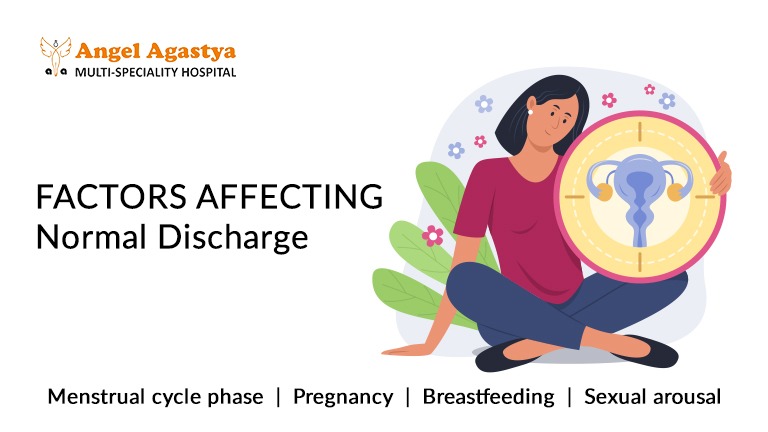Introduction:
Vaginal discharge, a natural and normal part of being a woman, often evokes unnecessary worry and discomfort. However, understanding its purpose, variations, and potential concerns can empower women to navigate this aspect of their health with confidence.
The Symphony Within:
Imagine your vagina as a self-cleaning orchestra, with every part playing a crucial role. Similar to how an orchestra needs a conductor, your body relies on vaginal discharge to maintain a balanced and healthy ecosystem. Produced by glands in the cervix and vagina, this discharge acts as a natural lubricant and barrier, protecting against harmful bacteria and preventing infections.

The Ever-Changing Rhythm of Vaginal Discharge:
Just like an orchestra plays different pieces with varying tempos, vaginal discharge exhibits its unique rhythm throughout your menstrual cycle. Fluctuating hormone levels influence its consistency, color, and amount:

- Follicular Phase (Days 1-13): Discharge might be scant, sticky, and white or clear, similar to egg white consistency. This reflects rising estrogen levels preparing your body for ovulation.
- Ovulation (Day 14 or around): Expect an increase in discharge, becoming clear, stretchy, and slippery, resembling egg white again. This “egg white cervical mucus” facilitates sperm travel, increasing the chances of conception.
- Luteal Phase (Days 15-28): Progesterone levels rise, making discharge thicker, creamier, and white or yellow. This is your body preparing for potential implantation or menstruation.
- Premenstrual Phase (Days 21-28): Discharge might decrease as your period approaches.
Remember, this is just a general overview, and individual variations in vaginal discharge are common. Don’t get stressed if your experience doesn’t perfectly match this description!
When the “Music” of Vaginal Discharge Changes its Tune:
While most vaginal discharge is a healthy sign, certain changes might indicate a need for medical attention. Don’t be afraid to listen to your body’s signals, and seek professional advice if you experience any of the following:

- A Color Change Drama: Green, yellow, or gray vaginal discharge can signal an infection like bacterial vaginosis or trichomoniasis.
- The “Something’s Fishy” Alert: A strong, unpleasant odor often accompanies vaginal discharge in bacterial vaginosis.
- The Itch that Just Won’t Quit: Burning, itching, or irritation around the vulva can be a sign of an infection or allergic reaction.
- The Clumpy Surprise: Thick, clumpy vaginal discharge, especially with an unpleasant odor, can be concerning, particularly if accompanied by other symptoms.
- Unexpected Spotting: Bleeding or spotting outside your usual menstrual cycle requires a check-up to rule out potential causes.
The Cast of Suspects Behind Abnormal Vaginal Discharge:
If you’re experiencing abnormal vaginal discharge, there could be various culprits behind the scene. Here are some common ones:

- Yeast infections: These are caused by an overgrowth of naturally occurring yeast (Candida albicans) in the vagina, leading to thick, white, clumpy vaginal discharge with burning and itching.
- Bacterial vaginosis: This is an imbalance of healthy and harmful bacteria in the vagina, causing a gray, thin vaginal discharge with a fishy odor, although not always accompanied by noticeable symptoms.
- Trichomoniasis: This sexually transmitted infection (STI) is caused by a parasite and can cause green, yellow, or frothy vaginal discharge with an unpleasant odor, along with itching and burning.
- Cervical infections: Chlamydia and gonorrhea, both STIs, can cause abnormal vaginal discharge with pelvic pain or burning urination.
- Other causes: Atrophic vaginosis (vaginal dryness), allergic reactions to soaps or detergents, and hormonal imbalances can also affect the characteristics of vaginal discharge.
Maintaining the Harmony of Vaginal Health:
Just like keeping your favorite instrument well-maintained ensures a beautiful melody, you can nurture and support your vaginal health through simple practices:

- Gentle Cleansing: Wash your vulva with warm water and mild, unscented soap, avoiding harsh chemicals and douches that can disrupt the natural balance of good and bad bacteria in the vaginal environment.
- Cotton Comfort: Choose cotton underwear for better airflow and moisture control. Synthetic fabrics can trap heat and moisture, creating an environment conducive to the growth of harmful bacteria.
- Safe Sex Practices: Using condoms consistently and correctly during sexual activity helps prevent STIs, which can disrupt the vaginal microbiome and lead to abnormal vaginal discharge.
- Healthy Habits: Maintaining a balanced diet, managing stress, and getting enough sleep contribute to overall well-being, including vaginal health.
- Listen to Your Body: Pay attention to changes in vaginal discharge and any accompanying symptoms. Don’t hesitate to consult your healthcare provider if you have any concerns, no matter how small they may seem. They are there to guide you and ensure your overall health and well-being.
Beyond the Basics: Understanding Common Concerns about Vaginal Discharge:
1. Can vaginal discharge affect my sex life?
While normal vaginal discharge is a natural lubricant, certain types of abnormal discharge, like those caused by infections, can cause itching, burning, or irritation, making sexual activity uncomfortable or even painful. If you experience any discomfort, consult your healthcare provider for diagnosis and treatment.
2. Is it normal to have vaginal discharge during pregnancy?
Yes! During pregnancy, hormonal changes can increase the amount and consistency of vaginal discharge, making it thicker, white, or milky. This is perfectly normal and doesn’t require any specific treatment. However, if you experience any changes in color, or odor, or are accompanied by itching or burning, seek medical advice.
3. Can certain medications affect my vaginal discharge?
Yes, some medications, like birth control pills, can alter the characteristics of vaginal discharge. If you notice any significant changes after starting a new medication, consult your healthcare provider to discuss potential causes and determine if any adjustments are necessary.
Summary:
Vaginal discharge, often shrouded in mystery and misconception, is a normal and healthy part of being a woman. It plays a crucial role in maintaining a balanced vaginal ecosystem, acting as a lubricant and protective barrier against harmful bacteria.
Throughout your menstrual cycle, hormonal fluctuations influence the characteristics of your discharge, causing variations in color, consistency, and amount. Understanding these variations empowers you to identify potential concerns.
While most discharge is healthy, certain changes like green, yellow, or gray color, strong odor, or itching and burning could indicate an infection and necessitate seeking medical advice. Common culprits include yeast infections, bacterial vaginosis, trichomoniasis, and cervical infections. Maintaining good vaginal health involves gentle cleansing with warm water and mild soap, opting for cotton underwear, practicing safe sex, and prioritizing a healthy lifestyle. Don’t hesitate to talk to your healthcare provider if you have any questions or concerns about your discharge – open communication is key to optimal well-being.
FAQs:
1. Can I use a menstrual cup with vaginal discharge?
Yes, you can use a menstrual cup with discharge. However, heavier discharge might require more frequent emptying of the cup. Choose a medical-grade silicone cup and ensure proper hygiene to avoid irritation.
2. Are there any apps that track vaginal discharge?
Several apps allow you to track your menstrual cycle and discharge characteristics. However, relying solely on an app for diagnosis or treatment is not recommended. Consult your healthcare provider if you notice any concerning changes.
3. Can vaginal discharge affect fertility?
Certain infections, like bacterial vaginosis, can potentially impact sperm motility and fertility. However, normal discharge does not negatively affect fertility.
4. How does the microbiome influence vaginal discharge?
The vaginal microbiome is a complex ecosystem of bacteria, and its balance plays a crucial role in maintaining healthy discharge. Factors like antibiotics, stress, and hygiene practices can affect the microbiome, potentially leading to changes in discharge.
5. Are there any genetic factors affecting vaginal discharge?
While not extensively researched, some evidence suggests genetic variations might play a minor role in susceptibility to certain infections that can cause abnormal discharge.
6. Can hormonal changes during menopause affect my discharge?
Yes, declining estrogen levels during menopause can lead to decreased vaginal lubrication and thinner, less frequent discharge. This is normal, but lubricants can be used if discomfort arises.
7. Can certain medical conditions affect vaginal discharge?
Yes, some medical conditions, like diabetes or autoimmune disorders, can indirectly affect discharge by compromising the immune system and increasing susceptibility to infections.
8. What are some emerging technologies related to diagnosing and managing vaginal health issues?
New technologies like point-of-care tests and microfluidics are being explored for faster and more convenient diagnosis of vaginal infections. Additionally, research on personalized treatment approaches based on individual vaginal microbiome profiles is underway.
9. What are the ethical considerations when discussing vaginal health online?
Discussing vaginal health online requires sensitivity and respect. It’s crucial to maintain anonymity, use accurate and evidence-based information, and avoid perpetuating myths or misinformation.
10. What resources are available for learning more about vaginal health?
Numerous reputable sources offer reliable information on vaginal health, including government health websites, medical professional organizations, and educational platforms. Consulting healthcare professionals remains the best option for personalized guidance and addressing specific concerns.


Best cucmber ever cucumber